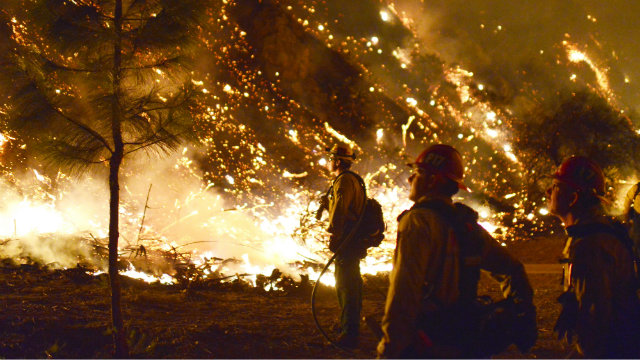SUMMARY
This is AI generated summarization, which may have errors. For context, always refer to the full article.

LOS ANGELES, California – California Governor Jerry Brown declared a state of emergency Friday, January 17, due to what could be the western US state’s worst drought in a century, which has sparked wildfires and hurt farmers.
The declaration allows authorities to access federal help to battle the dry spell that has left huge swaths of tinder-dry forest vulnerable to going up in flames.
On Thursday, a massive blaze raged just outside Los Angeles, damaging several homes and forcing residents to evacuate the area, where the fire risk had been elevated for weeks.
Brown urged state residents to reduce their water use by at least 20 percent.
“I’ve declared this emergency and I’m calling on all Californians to conserve water in every way possible,” he said in a statement.
“We can’t make it rain,” he added. “But we can be much better prepared for the terrible consequences that California’s drought now threatens, including dramatically less water for our farms and communities, and increased fires in both urban and rural areas.”
Brown told reporters in San Francisco that the current conditions were possibly “the worst drought that California has ever seen since records (began) about 100 years ago,” media reports said.
The region is suffering its third dry winter in a row, highlighted by the Los Angeles inferno.
California and other western US states are routinely hit with wildfires during the summer, but winter blazes, like the ones burning currently, are relatively rare.
California’s rivers and reservoirs have reached record lows, with only 20 percent of the normal average supplies of water from melting snowpack, which flows down from mountains like the Sierra Nevada.
“Water years 2012 and 2013 were dry statewide, especially in parts of the San Joaquin Valley and Southern California,” said the state’s Department of Water Resources (DWR) in its latest drought update.
“Water year 2014, which began on October 1st, continues this trend. Precipitation in some areas of the state is tracking at about the driest year of record.”
Farmer Mark Fontanilla was among dozens of people who staged a protest outside the state capitol in Sacramento on Thursday, urging Brown to do more.
“You can turn off your taps and minimize your pool and all that, but until we build more dams and increase the water storage, and get these clowns out of office, we’re gonna be importing our food from China,” he told KCRA television.
On average, half of California’s rain falls in December, January and February, the DWR noted, lamenting the lack of precipitation but saying it had not yet given up hope of some this winter.
“It is still too early, however, to call this water year, and Mother Nature may surprise us,” it said. –Rappler.com
Add a comment
How does this make you feel?
There are no comments yet. Add your comment to start the conversation.